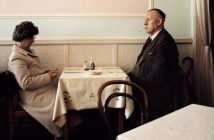Madonna’s W.E. is a film that switches between the lives of Wallis Simpson (Andrea Riseborough) and Edward VIII (James D’Arcy), the British king who gave up his throne in the name of love – and a rich doctor’s wife called Wally Winthrop (Abbie Cornish), living in modern day Manhattan and trying to come to terms with the fact that her marriage is a bit, well, rubbish really. Cue husband being cold, she wants a child desperately but that’s not going to happen anytime soon, and Cornish should win an Oscar for maintaining a melancholy face for the longest time on screen in a film ever! A bit fed up at her husband’s lack of interest in her and their marriage, Wally returns to her old hang-out, Sotheby’s, where an exhibition of items owned by Edward VIII and Wallis Simpson are being auctioned. At this point it might be of interest to say that she’s also fascinated by the fairytale romance between the Duke and Duchess.
While at the exhibition, Wally catches the eye of a handsome Russian security guard, who also happens to be talented in tinkling the ivories, aka, he can play the piano (Oscar Issacs). Eventually, as her marriage crumbles, Wally leaves her husband for the security guard. The film moves back and forth from the 1930s to the present day, highlighting the parallels between Edward and Simpson’s troubled and intense romance, and the modern day affair. The movie spent just a little bit too much time in the auction house, or is that how lots of rich, unhappy housewives spend their days? A bar and downing quite a few cocktails would be my way of dealing with a marriage going down the pan, rather than moping round looking at a whole load of historical archives, but then that’s just me.
Let’s concentrate on the film’s positives for now, and there are many, unlike Swept Away and Shanghai Surprise. 1) Madonna doesn’t star in it, hurrah! (I love her really), 2) It does a magnificent job of portraying the glittering socialite scene that was Simpson’s later life, and 3) I liked how the Wallis and Wally stories intertwined. Over many scenes the two women “visit” each other across time, with one featuring a ghostly Wallis telling a weeping Wally, “Darling, they can’t hurt you unless you let them”. The film also makes a valid point about how history has taught us to recall what Edward gave up in the pursuit of true love; but nobody has every truly documented what Simpson herself lost. Although she clearly cherished the king, she also felt trapped by his obsession for her. Cue Wallis being constantly hounded by the press – flashing pap cameras being a recurring motif in the film. A nod perhaps to how Madonna herself identifies with Simpson’s personal life being played out in public. The singer has often talked of her own fascination with the Windsor love affair – a passion which ultimately propelled her to make this film.
Riseborough and D’Arcy are both sublime in their roles, and steal your attention in every scene – there’s no mind wandering off to plan your shopping list with this movie. It was also good to see that D’Arcy did away with the self-indulgent brat mannerisms Guy Pearce gave his Edward in The King’s Speech. Instead, we see a man who was bold, strong and more than aware of the consequence of his actions.
The period scenes are also brilliantly brought to life with a glorious score by Polish-born composer Abel Korzeniowski (one of my personal favourites and also the composer behind Tom Ford’s “A Single Man” soundtrack). Oh, and how could I forget, the costumes, THOSE SPECTACULAR COSTUMES! As Wallis Simpson once said, “I’m not a beautiful woman. I’m nothing to look at, so the only thing I can do is dress better than anyone else” – and that she did! Madonna’s very own personal stylist and Oscar-nominated costume designer, Arianne Phillips, was responsible for the wardobe that could sell this film alone. Phillips visited museums in Paris (including archives at The Louvres), London and New York to study Simpson’s attire and also worked closely with labels such as Cartier, Dior (Wallis was one of Dior’s first clients ), Dunhill, and also commissioned jeweller Alexis Bittar to create one-off pieces for the film. Phillips also hired a replica crepe gown from London-based costume house, Cosprop – based on the original designed by Mainbocher, which Simpson wore to marry the Duke in 1937.
Simpson also purchased 18 items from the Elsa Schiaparelli Summer 1937 Collection for her Marriage Trousseau to the Duke, including a gown and jacket combination of carbon blue jersey with white leather baroque scrolls. The original and movie version can be seen in the gallery below.
Archive pieces by French label Vionnet also appeared in the film, as Simpson was a client of Madeleine, once cited as the “mother of couture”. After researching the archives of Simpson’s orders, the label re-created four couture creations for the film, including a shimmering metallic cocktail dress. A special installation also appeared in London’s Harvey Nichols last month to showcase the one-off designs, alongside the label’s latest Autumn/Winter collection.
Whether the film will be a hit or a miss with audiences when it opens on December 9th remains to be seen. The film has already been shown at the Venice and Toronto Film Festivals to mixed reviews, but Madonna herself revealed to The Guardian that she felt under most pressure screening it here in the UK: “It’s slightly nerve-wracking because it’s about a British king, it’s predominantly filmed in Britain, it’s a British production, most of my actors are English and I know the British can be tough critics. But I hope they like it.”
Well, as period dramas go, focusing on all things Royal generally proves to be popular with filmgoers (especially those Yanks) and the all-important Academy voters; for example, The Young Victoria (2009), Elizabeth: The Golden Age (2007), and Marie Antoinette (2005) didn’t do too badly. So there’s hope for the material girl yet, and of course, having thousands of fans boosting ticket sales and footfall in cinemas won’t hurt either. To quote Madge and her dancers in the 1991 all-access documentary Truth Or Dare: “Do we wanna be accepted by Hollywood?” Dancers: “No!” Six-ish films later and oh how things change.




